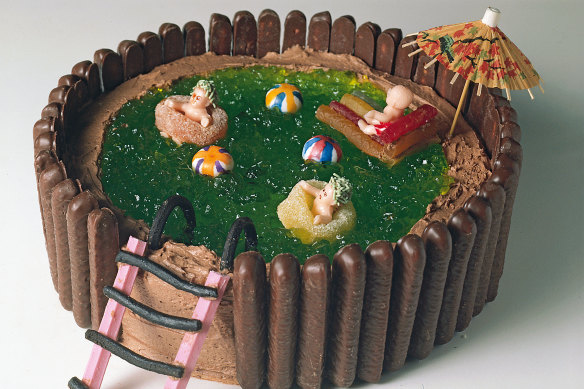This was published 4 months ago
The birthday cakes of your childhood will feature in a Rare Book Week display
They were cheap, readily available in supermarkets and newsagents and they revolutionised our tastes in food. They were the much-beloved Australian Women’s Weekly cookbooks.
Whether they were inserts in the magazines or published books, they were cooking bibles for Australian housewives from the 1930s onwards. The most popular and perennial was the children’s birthday cake book, first published in 1980, which was handed down the generations and is still available as a collector’s edition. The littlies would thrill to cakes themed on Humpty Dumpty, a choo-choo train or a jelly swimming pool.

The classic swimming pool cake from the Women’s Weekly Children’s Birthday Cake Book.
Food historian Lauren Samuelsson has been studying the books and talking to their users for her PhD, and will reveal her findings at the 2024 Melbourne Rare Book Week. Her talk is one of a bumper program of 45 free events, plus lectures and exhibitions, being held in Melbourne from July 18 and culminating in the annual Melbourne Rare Book Fair.
This year marks the 10th anniversary of Rare Book Week, described as a global beacon for book lovers and collectors. The attractions include a talk on how Jane Austen can help lawyers, 500 years of Ukrainian resistance in print, and a peek into the world’s first English printed book, made by William Caxton 550 years ago. (Disclosure: I am taking part in two events: with author and historian Lucy Sussex about mysteries and mayhem in 19th century Melbourne, and an interview with legendary bookseller Mark Rubbo about his career at Readings.)
Also, there’s a chance for bird lovers to see some very rare ornithology books at Melbourne Museum. State Library Victoria will feature first editions by Virginia Woolf and Toni Morrison, and other landmark women’s books acquired through the Library’s Women Writers Fund, plus a talk about the collection by historian Dr Anna Welch. James Joyce scholar Frances Devlin-Glass will discuss how censorship influenced Joyce’s revision of his novel Ulysses – and changed it for the better.

The Melbourne Rare Book Week will feature first editions by Virginia Woolf.Credit: AP
And there’s another event for cookbook fans: an evening with Elizabeth David and friends, presented by culinary bookseller Tim White, with a chance to sample several of her specialities.
You might not consider The Australian Women’s Weekly recipe collections rare books, but Samuelsson says some of the early titles are hard to come by, and she always keeps an eye open for them in op shops. It’s largely thanks to those recipe collections that we discovered variations on the traditional British meat and two veg.
As early as 1948, the recipes were coaxing mums to cook Chinese. Today, we’re surrounded by ingredients to cook any cuisine, Samuelsson says, “but this was revolutionary. The books offered different flavours and tastes and they took away the fear factor.” Instead of that exotic ingredient soy sauce, the books suggested using Worcestershire sauce.
You can see how much our tastes have changed by looking at some of the early AWW recipes. One for a family of six suggests using half a clove of garlic, but warns this will create “a very strong garlic taste”. “Chicken a l’orange” is boiled chicken breast with orange slices. Before the advent of factory farms, chicken was rare and expensive, so housewives were urged to create “mock chicken pie” by cooking shredded rabbit meat in pastry.
Perhaps the strangest offerings were the diets, pushed from the 1960s onwards. “The spaghetti diet” promised you could lose two kilos in a month by eating pasta. Samuelsson has posted videos of herself cooking some recipes, with mixed results. One was a 1950s recipe for jellied chicken and olive loaf. What was it like? “Unpleasant. It tasted all right, but the texture was not doing it for me.”
Janesullivan.sullivan9@gmail.com
Rare Book Week is on at venues throughout Melbourne July 18-27
The Booklist is a weekly newsletter for book lovers from books editor Jason Steger. Get it delivered every Friday.